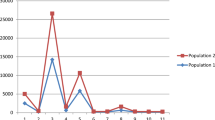Abstract
This study is concerned with construction of the generalized multivariate exponential estimator for estimating a population mean vector in the two-phase sampling using multi-auxiliary variables when population information for some auxiliary variables is not available. The optimum conditions which provide the matrix of minimum variance–covariance are obtained for the suggested estimator. Further, a vector of the biases is also provided. Some deduced univariate and multivariate estimators are also shown as special cases of the suggested multivariate exponential estimator. The simulation study is conducted using the artificial symmetric and asymmetric distributions to show that the suggested multivariate estimator performs more efficiently than the existing multivariate estimator. Two real-life examples are used to show the usefulness of the proposed multivariate estimators.
Similar content being viewed by others
References
Cochran WG (1940) The estimation of the yields of cereal experiments by sampling for the ratio of grain to total produce. J Agric Sci 30:262–275
Chand L (1975) Some ratio type estimators based on two or more auxiliary variables. Unpublished Ph.D. thesis, Iowa State University, Ames, Iowa (USA)
Srivastava SK, Khare BB, Srivastava SR (1990) A generalized chain ratio estimator for mean of finite population. J Indian Soc Agric Stat 42:108–117
Gupta S, Shabbir J (2008) On improvement in estimating the population mean in simple random sampling. J Appl Stat 35(5):559–566
Singh R, Chauhan P, Smarandache F (2011) Improvement in estimating population mean using two-auxiliary variables in two-phase sampling. Ital J Pure Appl Math 28:135–142
Bahl S, Tuteja RK (1991) Ratio and product type exponential estimators. Inf Optim Sci 12(1):159–163
Yadav R, Upadhyaya LN, Singh HP, Chatterjee S (2013) A chain ratio exponential type estimator in two-phase sampling using auxiliary information. Statistica 73(2):221
Sanaullah A, Ali HA, Noor-ul-Amin M, Hanif M (2014) Generalized chain ratio estimators under stratified two-phase random sampling. Appl Math Comput 226:541–547
Sanaullah A, Noor-ul-Amin M, Hanif M (2015) Generalized exponential-type ratio-cum-ratio and product-cum-product estimators for population mean in the presence of non-response under stratified two-phase random sampling. Pak J Stat 31(1):71–94
Singh HP, Vishwakarma GK (2007) Modified exponential ratio and product estimators for finite population mean in two-phase sampling. Austrian J Stat 36:217–225
Solanki RS, Singh HP, Rathour A (2012) An alternative estimator for estimating the finite population mean using auxiliary information in sample surveys. ISRN Probab Stat. https://doi.org/10.5402/2012/657682
Khan H, Sanaullah A, Khan MA, Siddiqi FA (2014) Improved exponential ratio type estimators for estimating population mean regarding full information in survey sampling. Sci Int (Lahore) 26(5):1897–1902
Singh GN, Majhi D (2014) Some chain-type exponential estimators of population mean in two-phase sampling. Stat Trans Ser 15(2):221–230
Singh HP, Solanki SR (2014) An efficient class of estimators for the population mean using auxiliary information. Commun Stat Theory Methods 42(1):145–163
Sanaullah A, Khan H, Ali HA, Singh R (2012) Improved ratio type estimators in survey sampling. J Reliab Stat Stud 5(2):119–132
Olkin I (1958) Multivariate ratio estimation for finite populations. Biometrika 45:154–165
Sen AR (1972) Successive sampling with p(p ≥ 1) auxiliary variables. Ann Math Stat 43:2031–2034
Ceccon C, Diana G (1996) AClassi di stimatori di tipo rapporto in presenza di piu variabili ausiliarie. In: Proceedings of Italian statistical society XXXVIII scientific meeting, Rimini 9–13 April 1996, pp 119–126
Naik VD, Gupta PC (1991) A general class of estimators for estimating population mean using auxiliary information. Metrika 38:11–17
Singh HP, Namjoshi UD (1988) A class of multivariate regression estimators in two-phase sampling. Assam Stat Rev 2:1–7
Tripathi TP, Khattree R (1989) Simultaneous estimation of several means using multivariate auxiliary information. Technical Report No. 13/89 Stat/Math ISI Calcutta
Tripathi TP (1989) Optimum estimation of mean vector for dynamic population. In: Invited paper in the proceeding of international symposium on optimization and statistics, held at AMU. Aligarh
Ahmed MS (2003) General chain estimators under multi-phase sampling. J Appl Stat Sci 12(4):243–250
Ahmad Z, Hanif M, Ahmad M (2010) Generalized multi-phase multivariate ratio estimators for partial information case using multi-auxiliary variables. Commun Korean Stat Soc 17(5):625–637
Hanif M, Ahmad Z, Ahmad M (2009) Generalized multivariate ratio estimator using multi-auxiliary variables for multi-phase sampling. Pak J Stat 25(4):615–629
Singh S (2003) Advanced sampling theory with applications. Kluwer Academic Publishers, Dordrecht
Author information
Authors and Affiliations
Corresponding author
Additional information
Publisher's Note
Springer Nature remains neutral with regard to jurisdictional claims in published maps and institutional affiliations.
Appendices
Appendix 1
1.1 Simulation Study for Symmetric Data
1.2 Simulation Study for Asymmetric Data
Appendix 2
2.1 Empirical Results Based on Real-Life Examples
See Tables 9, 10, 11, 12, 13, 14 and 15.
Rights and permissions
About this article
Cite this article
Sanaullah, A., Ayaz, A. & Hanif, M. A Multivariate Exponential Estimator for Vector of Population Means in Two-Phase Sampling. Proc. Natl. Acad. Sci., India, Sect. A Phys. Sci. 90, 647–659 (2020). https://doi.org/10.1007/s40010-019-00633-4
Received:
Revised:
Accepted:
Published:
Issue Date:
DOI: https://doi.org/10.1007/s40010-019-00633-4



